A pet eagle would be one of the best pets I could ever own but that is just my opinion.
I would love to be able to train a pet eagle and have it do awesome aerial maneuvers and dives.
Could you imagine having your pet eagle on your shoulder at a park while all your friends are either in awe or scared to bits?!
Unfortunately, I will just have to dream about owning a pet eagle because it is simply impossible to accomplish in real life.
Can You Have a Pet Eagle?
Eagles are wild and native species that are protected under the Migratory Bird Treaty Act of 1918 just like most other wild and native bird species. This treaty states that it is unlawful to capture, kill, trade, and transport any native or wild migratory birds.
This treaty includes conservation efforts from the United States, Canada, Japan, Russia, and Mexico.

Can You Have a Pet Eagle in The United States (U.S.)?
Since eagles are native species and are included in the Migratory Bird Treaty Act, it is illegal to own a pet eagle in the United States. The treaty states that it is illegal to capture, kill, trade, and transport any eagle species within the United States.
To own a “pet” eagle, you would need a valid and special permit from the government and you can be assured they won’t issue a permit for a pet eagle.
They do issue permits for various purposes and have a few exceptions for Native Americans, but to own a pet eagle is not one of them.
Some eagle species (bald eagles and golden eagles) are also protected under the Bald and Golden Eagle Protection Act (BGEPA) which was enacted in 1940.
This Act prohibits any person without a valid permit issued by the Secretary of Interior from taking bald or golden eagles.
This is not specific to just banning pet eagles because it also prohibits the taking of eagle parts (including eggs, feathers, and nests).
Can You Have a Pet Eagle in Canada?
Since Canada also adheres to the Migratory Bird Treaty Act, owning a pet eagle is illegal in all of Canada. Not only is it illegal to own a pet eagle, but you also can’t disturb an eagle’s nest and take any eagle parts including feathers.
The purpose of this bird Act is to help protect and restore migratory bird populations.
The Act also ensures future generations will have sustainable, undisturbed habitats and gives them a positive long-term outlook for sustainability and growth.
Can You Have a Pet Eagle in Australia?
Pet eagles are illegal in all Australian states and territories. Eagles are fully protected as “birds of prey” or “raptors”. Individual States and Territories hold their own legislation regarding eagles as pets, but they all define legal protection for raptors that are native to Australia.
Australia has very strict regulations as it pertains to native wildlife occurring in all Australian states and territories, especially in regard to illegal export.
Although all states and territories have different legislatures, none of them include legally owning a pet eagle.
Can You Have an Eagle as a Pet in The United Kingdom (UK)?
Wild birds of prey are illegal to keep as pets in the UK according to the Wildlife and Countryside Act 1981, which includes owning a pet eagle. This Act specifically states that no person shall injure, kill, take, disturb, or trade wild animals (including eagles).
Since eagles are raptors or birds of prey, it will be impossible to keep a pet eagle in the UK.
If you are a handler or a keeper, you can apply for a valid permit and register your bird of prey (which is considered a section 7, schedule 4 bird), but the eagle will need to be closed-ringed or microchipped.
8 Popular & Common Eagle Species
Below are 8 popular and common eagle species found around the world.
1. Bald Eagle

Native to North America, bald eagles are at the top of the food chain. They have no real natural predators in the wild and thrive when they can be left alone by humans.
Bald eagles aren’t bald, but rather get the name due to their white-feathery head.
Bald eagles like to prey on fish but their diet also consists of crabs, small birds and mammals, snakes, and turtles.
While they thrive as birds of prey in the wild, their numbers have decreased from hundreds of thousands over the past few centuries due to human activities and environmental factors.
Bald Eagle Physical Attributes
| Average Weight | 10.3 lbs (4.7 kg) |
| Average Length | 3 ft, 3 in (99 cm) |
| Average Wingspan | 6 ft, 6 in (198 cm) |
2. Crowned Eagle
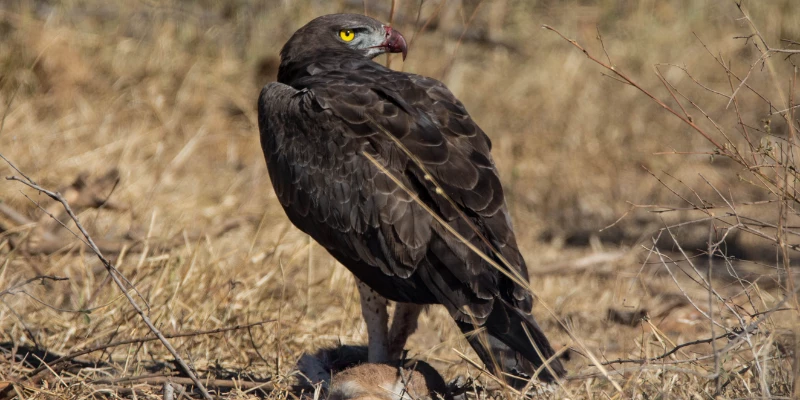
The crowned eagle (also known as the African eagle or crowned hawk-eagle) can be found in Southern Africa in eastern areas.
They are the most powerful eagle found in Africa. These birds of prey prefer habitats made up of woodlands and forests.
Their diets mainly consist of monkeys but they also eat feral cats, monitor lizards, mongooses, rats, small antelope, and snakes.
Crowned Eagle Physical Attributes
| Average Weight | 7.5 lbs (3.4 kg) |
| Average Length | 2 ft, 10 in (87.5 cm) |
| Average Wingspan | 5 ft, 5 in (165 cm) |
3. Golden Eagle
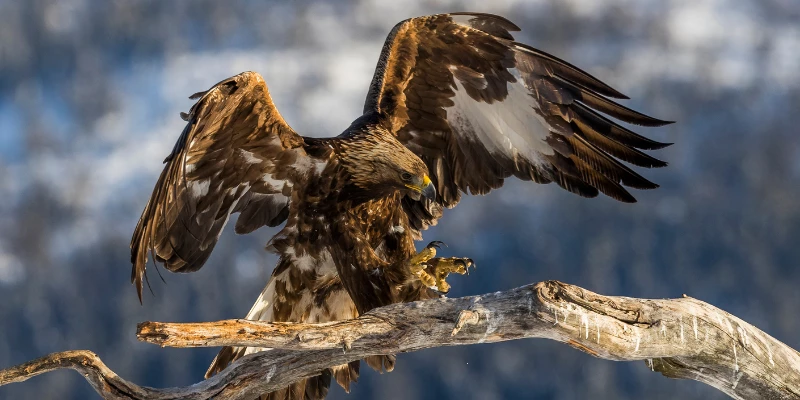
Golden eagles can be found in the Northern Hemisphere and are the most widely dispersed species of eagle in the world.
Golden eagles have great agility and speed with large, sharp talons. They are built to stalk and hunt various different types of prey.
Golden eagles like to build their nests at high elevations and on cliffs. Golden eagles and bald eagles are the only two native eagle species that can be found in the United States.
Golden Eagle Physical Attributes
| Average Weight | 9 lbs (4.1 kg) |
| Average Length | 2 ft, 9 in (84 cm) |
| Average Wingspan | 6 ft, 9 in (207 cm) |
4. Harpy Eagle
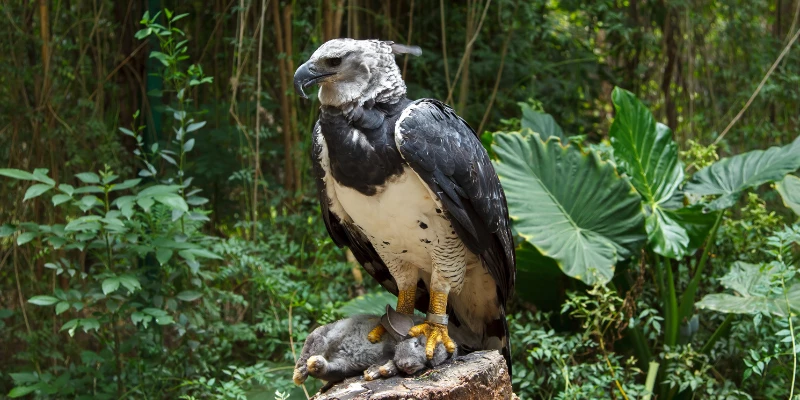
Harpy eagles – sometimes referred to as American harpy eagles for the American eagles and Papuan eagles for the New Guinea eagles – are the largest and most powerful birds of prey throughout their habitats and are also among the largest species of eagles in the world.
American harpy eagles used to be distributed throughout southern Mexico, Central and South America, and down to northern Argentina.
However, American harpy eagle numbers have dwindled over the years and the largest known breeding population can be found in Panama near the border of Columbia.
Harpy eagles have a diet that consists of various species of prey. Harpy eagles eat monkeys, porcupines, sloths, other birds, snakes, turtles, and foxes.
Harpy Eagle Physical Attributes
| Average Weight | 13 lbs (5.95 kg) |
| Average Length | 3 ft, 3 in (98.5 cm) |
| Average Wingspan | 6 ft, 6 in (198 cm) |
5. Martial Eagle
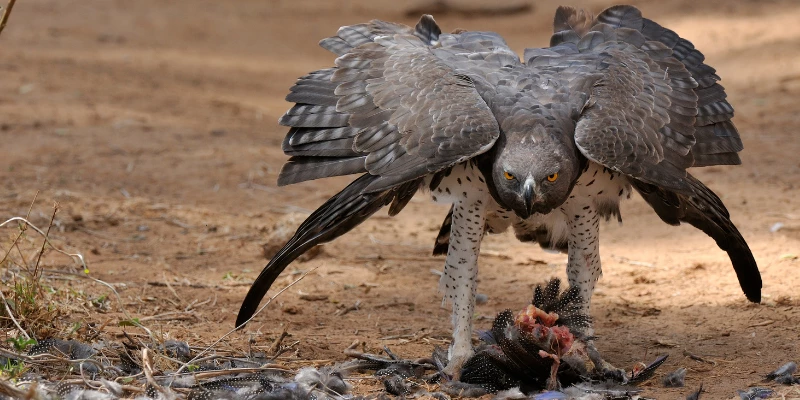
Martial eagles are large eagles that are native to Africa, in sub-Saharan Africa to be exact. This species is one of the strongest and most powerful species among booted eagles.
Martial eagles are classified as endangered by the IUCN and are one of the most persecuted eagle species in the world.
These eagles have been ridiculed by farmers and are accused of attacking livestock and valuable game causing farmers and game wardens to attempt to eliminate any martial eagle that is found within range of farms.
Martial eagles have a diet that consists of small birds, small mammals, monkeys, monitor lizards, mongooses, dik-diks, hares, and a variety of other animals and birds.
Martial Eagle Physical Attributes
| Average Weight | 10.25 lbs (4.6 kg) |
| Average Length | 2 ft, 8 in (81 cm) |
| Average Wingspan | 6 ft, 9 in (206.5 cm) |
6. Philippine Eagle

Philippine eagles get their name because they can be found in the forests of the Philippines. They are sometimes referred to as monkey-eating eagles or great Philippine eagles.
These eagles are also endangered (critically) and are known as the national bird of the Philippines.
Philippine eagles have a diet that mainly consists of monkeys but they are also known to have a variety of different prey.
Philippine eagles also eat bats, civets, flying squirrels, lizards, other birds and birds of prey, and snakes.
Philippine Eagle Physical Attributes
| Average Weight | 14 lbs (6.5 kg) |
| Average Length | 3 ft, 3 in (100 cm) |
| Average Wingspan | 6 ft, 9 in (207 cm) |
7. Wedge-Tailed Eagle
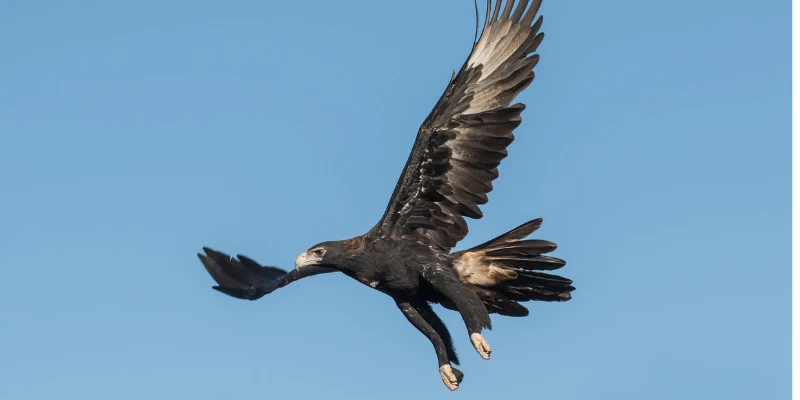
Wedge-tailed eagles get their name because of their tails that are shaped like wedges. A wedge-tailed eagle is the largest eagle and largest bird of prey found on the continent of Australia.
These eagles can also be found in places like New Guinea and Tasmania.
Wedge-tailed eagles have a diet that consists of other birds, bandicoots, hares, kangaroos, lizards, possums, wallabies, and other mammals and small birds.
Wedge-tailed eagles can be found in habitats including deserts, plains, mountain regions, and forests (some in tropical rainforests).
Wedge-Tailed Eagle Physical Attributes
| Average Weight | 7.6 lbs (3.5 kg) |
| Average Length | 3 ft, 2 in (95.5 cm) |
| Average Wingspan | 6 ft, 11 in (210 cm) |
8. White-Tailed Eagle

White-tailed eagles are very large sea eagles that can be found across Europe and Asia. Some people refer to them as white-tailed sea eagles, Eurasian sea eagles, and gray sea eagles.
They live in habitats near large bodies of water which can be near coastal saltwater areas, freshwater lakes, rivers, and wetlands.
White-tailed eagles have a diet that consists of a lot of fish but they are scavengers and opportunistic birds of prey.
They are known to steal prey from other birds and predators.
Aside from fish, white-tailed eagles also eat hares, rabbits, water birds, and other small mammals.
White-Tailed Eagle Physical Attributes
| Average Weight | 10.5 lbs (4.8 kg) |
| Average Length | 2 ft, 8 in (81 cm) |
| Average Wingspan | 7 ft, 2 in (218.5 cm) |
Are Eagles Good Pets?
Eagles are not good pets because it is illegal to have a pet eagle. Due to the restrictions in place within the Migratory Bird Treaty, it is impossible to keep a pet eagle, and permits are only reserved for keepers and handlers that have valid reasons to keep an eagle but not as a pet.
Pet eagles wouldn’t be ideal pets for most pet owners anyway, considering they are birds of prey, can be aggressive, and are territorial birds.
Eagle Physical Details
An eagle’s physical characteristics will vary from species to species but the majority of eagle species are among the largest and heaviest birds in the world.
Of the 8 eagle species listed above, the average length is around 3 feet with an average wingspan of around 6 and a half feet, with an average weight of around 10 to 11 pounds.
Eagle Behavior & Temperament
Below are some common questions that you should know about eagle behavior and temperament.
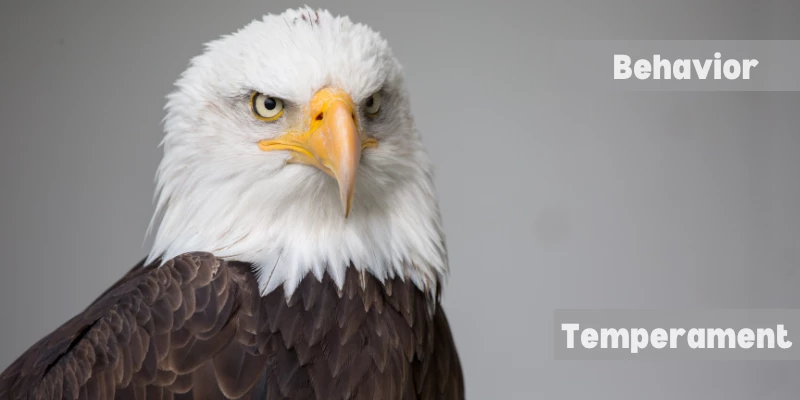
Are Eagles Aggressive?
Eagles can be aggressive toward humans and have been known to attack humans from time to time.
Attacks usually occur during breeding season because eagles become much more aggressive and territorial at this time.
Since eagles are aggressive, this would be another reason a pet eagle wouldn’t be a good idea.
Are Eagles Dangerous?
Eagles can be dangerous for humans and can attack us, but the injuries are not lethal.
Eagles have large, sharp talons that can cause major cuts to your head, neck, shoulders, and arms.
Although they may not kill you if you get attacked by one, you’d probably not want to see another eagle in your lifetime.
Would you still want a pet eagle after hearing that?
Are Eagles Affectionate?
Eagles are birds of prey and aren’t typically the affectionate type to humans.
Some handlers have grown bonds with eagles and some of those eagles may even enjoy being touched, but the majority will not.
If you had a pet eagle, it wouldn’t likely be affectionate towards you, but it may grow a bond with you because you would be its feeder and it all boils down to food.
Are Eagles Friendly?
Most eagles will not be friendly toward humans. Most species of eagles prefer to avoid humans either because they are afraid of us or because they just don’t like us.
Pet eagles wouldn’t be popular among the majority of pet owners due to their predatory and aggressive nature.
Are Eagles Solitary?
Most eagles are solitary birds unless it is mating season. Some eagles will travel together to food sources or follow other eagles to those food sources, but not many travels in flocks.
Most eagles like to be alone, fly alone and are very independent birds only coming together around food sources and during breeding.
Are Eagles Territorial?
Eagles are very territorial especially when it comes to mating season, food sources, and when they find a suitable nesting tree away from human interaction.
Some eagles will gather around food sources and get along to a certain extent, but most are territorial and don’t like intruders trespassing in their habitats.
What do Eagles Eat?
Depending on the species of eagle, their diets consist of a variety of animals. Eagles eat fish, hares, mongooses, monkeys, other birds (including birds of prey), rabbits, raccoons, and many other small mammals.
Eagle Habitat
Eagles need open space to roam and fly. They are not house birds and would not be happy sitting in a cage all day.
Let’s go over the eagle’s habitat in the wild and then what would be needed for a pet eagle.
Eagle Habitat In the Wild
Depending on the species of eagle, they can be found in forests, open plains, around open bodies of water, on cliffs, in tropical forests, and in mountainous regions – among a variety of other habitats.
Eagle Habitat as a Pet
Since you can’t have a pet eagle, this is just a hypothetical scenario, but you would need a large enclosure and lots of meat for your pet eagle to eat.
It wouldn’t be easy to keep an eagle as a pet because they need the ability to free-roam and have a wide area range to fly.
15 Commonly Asked Questions About Eagles
Below are 15 common questions (along with answers) that we get asked about eagles a lot, so I figured I’d share them here with you.

1. What Are Eagles Known For?
Eagles are known for their wide wingspans, heavy heads, and their hooked beaks. They also have very strong and sharp talons for swooping in and snatching up their prey.
2. How Long Can Eagles Live?
An eagle’s lifespan varies from species to species but on average, they can live to be between 12 to 30 years.
Bald eagles live up to 30 years while crowned eagles typically have a lifespan of around 14 years.
3. Are Eagles Smart?
Eagles are very smart birds of prey. They are very intelligent and can even work in pairs to catch prey.
Some even know to dive in from the sun to have the advantage of prey not being able to see them due to the blinding sun.
4. How Strong Are Eagles?
Eagles are very strong birds. Some, such as the bald eagle, can lift prey up to 5 pounds in weight and have a grip strength of about 400 pounds per square inch.
A golden eagle has even more strength with a grip of about 750 pounds per square inch.
5. Are Eagles Dangerous to Humans?
An eagle will attack a human if it is protecting its territory and also during the breeding season.
These attacks are not vicious enough to be fatal, but eagles can do some damage with their long, sharp talons.
6. Do Eagles Have Predators?
Yes, eagles do have predators. These predators include hawks, humans, and raccoons.
Adult bald eagles don’t have any natural predators (in the wild) but their chicks are vulnerable to bears, bobcats, foxes, raccoons, wolverines, and other large birds.
7. What Are Male and Female Eagles Called?
Both male and female eagles are just known as eagles. Unlike other birds, there is no name distinction between males and females.
8. What Are Baby Eagles Called?
Baby eagles are known as either fledglings or eaglets. A young eagle is called an eaglet before its first flight.
After the first flight, the young eagle is then called a fledgling.
Baby eagles are also called hatchlings when first born but some people will also refer to baby eagles as chicks.
9. Which Eagles Are the Most Powerful?
Harpy eagles are the most powerful eagles in the world. They can crush their prey with their legs and talons at more than 100 pounds of pressure, which is comparative in power to the jaws of a Rottweiler.
10. Where Do Eagles Build Their Nests?
Most eagles build their nest on the tops of trees. They will find the crotch of branches and build a large nest with sticks and branches lined with softer material such as grass and twigs.
11. Which Eagle Species Is the Largest Eagle?
Philippine eagles (also known as giant Philippine eagles) are the largest eagles in the world.
They average about 3 feet in height and are one of the heaviest eagle species in regards to mass (weighing an average of 14 pounds).
12. Which Eagle Species Are Found (native) in The United States?
Bald eagles and golden eagles are the only eagle species that are native to the United States and North America.
Bald eagles have a habitat range that extends through Mexico, Canada, and the United States.
They can be found in Alaska, along the West and East coasts, in the Rocky Mountains, and near the Mississippi River.
Bald eagles are only found in North America.
Golden eagles also have a habitat range that extends through Mexico, Canada, and the United States.
Not only are golden eagles found in North America, but they can also be observed in natural habitats in northern Africa, Asia, and Europe.
13. How Far Can Eagles See?
Eagles have excellent eyesight and can see as far as two miles. They can see much more clearly than humans, about eight times clearer.
Most birds of prey have great eyesight due to having to spot their prey from great distances in the sky.
14. Do Eagles Have Teeth?
No, eagles do not have teeth. Instead of teeth, eagles use their sharp beaks and talons along with their strong neck muscles to rip apart prey into smaller pieces that are small enough for them to swallow.
15. Can an Eagle Carry a Human?
No, an eagle is not strong enough to carry a human. Most birds of prey can’t lift more than their body weight.
This would equate to just a few pounds for most birds.
Maybe a small pet, but eagles are not strong enough or big enough to carry an adult human or even babies.
Recap
There you have it! Now you know you can’t have a pet eagle. These birds of prey are protected and prohibited as pets.
Most eagle species would not be a great fit as a pet anyway and most humans would not be able to handle a pet eagle due to their aggressive, solitary, and territorial nature.
It is best to leave these birds of prey alone in their natural habitats where they can thrive and we can admire them from afar.
Pet eagles are not going to be a thing as is the case with most other native and wild bird species.
Could they be great pets for some people?
Maybe! But we shall never know unless the laws change and I don’t see that happening anytime soon.





